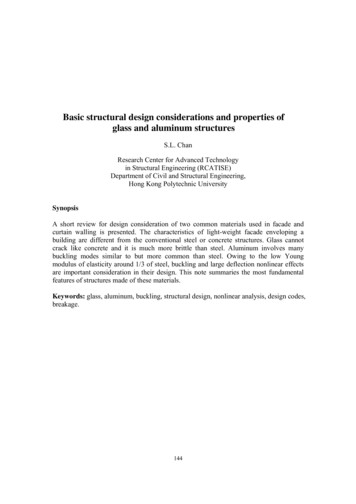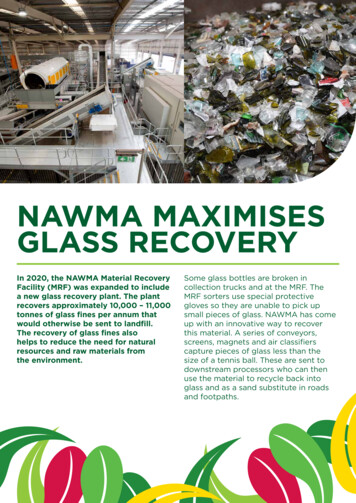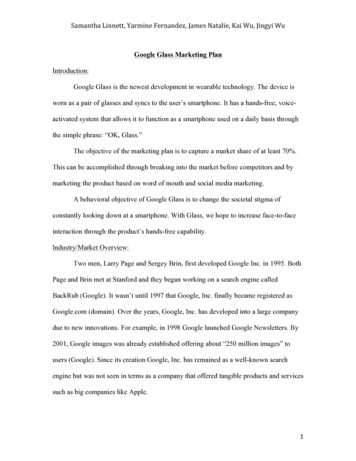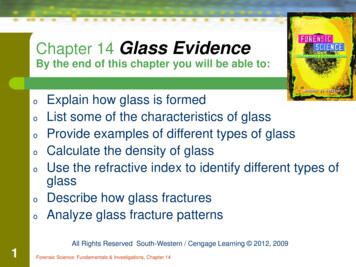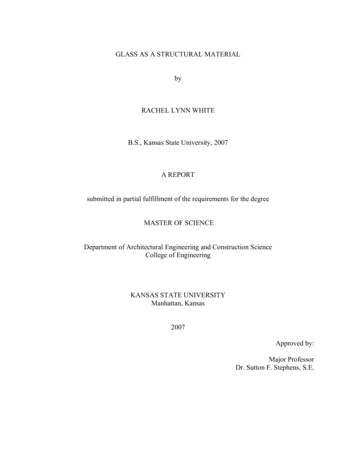
Transcription
GLASS AS A STRUCTURAL MATERIALbyRACHEL LYNN WHITEB.S., Kansas State University, 2007A REPORTsubmitted in partial fulfillment of the requirements for the degreeMASTER OF SCIENCEDepartment of Architectural Engineering and Construction ScienceCollege of EngineeringKANSAS STATE UNIVERSITYManhattan, Kansas2007Approved by:Major ProfessorDr. Sutton F. Stephens, S.E.
AbstractGlass can be beautiful and strong, so why is it not used more often as a structuralmaterial? Most often the reasoning is because people fear its perceived fragile and dangerousnature. Although this is the perception, it is far from the reality. Structurally designed glass caneven withstand higher loads than steel. The following report will present several advantages ofusing glass as a structural material. Because understanding the history of glass can foster agreater understanding of where the future of glass is headed, it is discussed early on. After this,the focus is on how to make a mixture of molten liquid into a structural member. Themanufacturing process is at the root of the strength of glass, as are the material properties. Thecomposition and properties of glass are addressed before discussing various uses of glass as astructural material. As architects begin to ask for more structural glass in their projects, structuralengineers must be prepared to design the systems or to specify performance criteria to a specialtyengineer. To aid in design, published guidelines and testing must be utilized and are thereforediscussed. In a glass structural system, the glass is not the only aspect that needs an engineer’sattention. Connections present a special challenge when designing with structural glass, butseveral different forms of connections have been successfully demonstrated in construction. Totie all the previous topics together, three examples of structural glass systems are presented.Europe has been using glass as a structural material for years, but the United States has beenslow to follow the trend. Glass has been proven to work as a structural material that can createimpressive visual impact. With the support of the glass manufacturing industry and the courageof design engineers, the United States could easily start a movement towards building withstructural glass.
Table of ContentsList of Figures . ivList of Tables . vAcknowledgements. viCHAPTER 1 - Introduction . 1CHAPTER 2 - History . 3CHAPTER 3 - Manufacturing Process . 9Finishing Processes. 11CHAPTER 4 - Material Properties . 15Composition of Glass. 15Properties of Glass . 17CHAPTER 5 - Glass as a Structural Material. 25CHAPTER 6 - Design Guidelines and Testing. 33Design Guidelines. 33Material Testing. 35CHAPTER 7 - Connections . 40CHAPTER 8 - Examples of Glass Structures. 49R.O.A.M Glass House . 49The Arnhem Zoo Bridges . 50Apple SoHo Staircase . 53CHAPTER 9 - Conclusion. 55References. 57Appendix A - Timetable of Glass History . 60Appendix B - ISG Standard Glass Fin Wall Specifications . 63iii
List of FiguresFigure 1-1 Main Train Station in Berlin, Germany (Personal Picture). 2Figure 2-1 Blowing a Glass Globe (Personal Picture). 4Figure 2-2 Method for Spinning Flat Glass (Maloney 63) . 6Figure 4-1 Stress-Strain Curve of Common Materials (Loughran 107) . 18Figure 4-2 Identifying the Cause of Failures (Loughran 26). 23Figure 4-3 Armored Laminated Glass Structure (Kaltenbach 35). 24Figure 5-1 Sonsbeek Art Exhibition Pavilion (Nijsse 18) . 27Figure 5-2 Failure Modes of Columns (Nijsse 60) . 30Figure 5-3 Laminated Glass Column Configurations (Nijsse 69) . 30Figure 5-4 Cross-Shaped Column (Nijsse 72) . 32Figure 6-1 Sketch of Floor for Example Problem (Personal Picture). 37Figure 6-2 ASTM E1300-02 Figure A1.41 (ASTM 1439). 39Figure 7-1 Connection for Point Supported Glass System (Novum Online). 40Figure 7-2 Glass Truss Connection (Nijsse 64). 42Figure 7-3 Connection Detail for Glass Beam to Insulated Glass Panel (Nijsse 24) . 44Figure 7-4 Edge Clamped Glass With Stiff Silicone Pads (Novum Online). 45Figure 7-5 Point-Fixing Glazing Connection (Loughran 20) . 47Figure 7-6 Bolt Loaded in Compression (Persson Online). 48Figure 7-7 Bolt Loaded in Bending (Persson Online) . 48Figure 8-1 Sketch of Structural Glass Wall and Roof Structure (Nijsse 108) . 50Figure 8-2 Exploded View of the First Arnhem Zoo Glass Bridge (Nijsse 30) . 51Figure 8-3 The Completed Second Arnhem Zoo Bridge (Nijsse 31) . 52Figure 8-4 Apple SoHo Staircase (Stairs Online). 54iv
List of TablesTable 3-1 Practical Stress Limits for Commercial Annealing (Phillips 230) . 12Table 4-1 Composition of Common Glass Types (Phillips 42). 16Table 6-1 ASTM E1300-02 Table 1 (ASTM 1394) . 38Table A-1 History of Glass and Mankind. 60v
AcknowledgementsFirst, I thank my major professor, Sutton Stephens, for his continuous support in myMaster’s program. Sutton was always there to answer questions and give advice. Hecontinuously provided positive feedback that served to improve my work. I also thank KimberlyKramer, a committee member and the Architectural Engineering director of graduate studies.Kim was very helpful in my search for a topic and in guiding me through the Graduate Schoolapplication process. Next, I would like to thank Darren Reynolds, a supportive member of mycommittee who was encouraging of my topic and research. Finally, I would like to acknowledgeMr. Patrick Loughran and the Birkhäuser publishing company for granting me permission to usetheir illustrations in this work.vi
CHAPTER 1 - IntroductionEven though it is technically liquid, glass could be the greatest structural material knownto man. It is considered a liquid because the molecules are disorganized like in a fluid, but theyare rigidly bound like a solid. Architects love glass because it does not obstruct a view orvisually interrupt a room. Structural engineers should love it because when theoreticallycompared to steel, it can carry two times the tension load (Maloney 30). Also, because glass isthe most recycled material in the world, the supply is plentiful and non-detrimental to theenvironment (Nijsse 21). However, theory and practice are two different things. While glasswould win in a theoretical competition for the best building material, it would fail in a practicalcontest. Both social and physical limitations must be overcome before glass can gain widespreadacceptance as a structural material.The social limitations of glass include the psychological effects of having no privacy andthe stigmata that glass is fragile and weak. The Russian film director Sergei Eisenstein is famousfor showing the human desperation that is caused by too much openness and lack of privacy(Nijsse 11). To an extent, this constraint can be overcome by using translucent or frosted glass.As for the perception that glass is fragile and weak, this can be overcome with education. Inactuality, glass is very strong and versatile. Because most people feel glass is dangerous,building with it is very risky. This risk is what keeps many owners from asking for it and manycontractors from agreeing to build with it.Actual physical limitations do hinder the growth in the use of glass as a structuralbuilding material. The main weakness with glass is its brittle nature. Glass must meet thefollowing criteria to be considered brittle: It will fail in tension and not shear, and will deformvery little before it breaks. Finally, glass develops forked fractures due to internal stresses. Whenan original fissure is traveling with explosive violence, smaller splits will propagate throughoutthe glass (Phillips 63). To demonstrate the lack of plasticity in glass and the immense brittlenature, the velocity of crack propagation is examined. A crack travels through glass at about5040 feet per second, which is one-third the speed of sound through glass. At that speed, a crackwould travel 2.5 inches in only 1/24,000 second (Phillips 70). The brittleness of glass keeps it from1
redistributing forces, which causes intense stress concentrations. Typically, failures in glass aredue to these concentrations.Through an understanding of the properties of glass, one could realize the manypossibilities of glass in structural applications. One such example is the Berlin main train stationshown in Figure 1-1. Knowing how glass is manufactured and its material properties will aide inan understanding of glass as a structural material. To design any structure, an engineer mustfollow codes and specifications. An added complication of designing glass is how to hold thestructure together. Connections can determine the difference between stability and failure. Afterreviewing all of the factors that effect glass design, looking at examples will bring everythingback together. In today’s society, fear and economics hold glass designers back. Until that fear isovercome by a better understanding of the strengths and limitations, glass will never move intomainstream construction in the United States (Davidson Online).Figure 1-1 Main Train Station in Berlin, Germany (Personal Picture)2
CHAPTER 2 - HistoryGlass existed, even before humans intervened. Before humans began to artificiallymanufacture glass, it occurred naturally. One such glass is obsidian, a volcanic rock that is rarelytransparent and more typically translucent. While some light can pass through a stone ofobsidian, it cannot be seen through. It is theorized that this type of glass was used by inhabitantsof the Stone Age for various purposes. For example, arrowheads, spearheads, knives, and razorswere easily crafted with little skill (Phillips 3). Beads could also be easily fabricated by carvinglarge blocks of solid glass into the desired size and shape (Maloney 50).The first use of man-produced glass was as glazing. Glaze was a decorative coating ofglass around a vessel made of another material. The item to be glazed was given a new exteriorlayer by dipping it in molten glass. Once the glass had set, the vessel was reheated and threads ofcolored class were pressed in to add designs (Maloney 51). Stone beads have been found thatused glass as a decorative coating. Some beads from Egypt have been dated as early as 12,000B.C.(Phillips 4). Glazing was also very common during the Eighteenth Dynasty in Egypt from1500 to 1250 B.C. During this time, glass was used to adorn various pottery pieces and stones. Itwas typically done by coating a sand form or core with several layers of molten glass. Once theglass was thick enough to support itself, the sand core was removed leaving a shell type vessel.Many experts agree that glassmaking began in Egypt because after the discovery of the glazingmethod, glassmaking became a very stable and long-lasting industry (Maloney 51).While a number of experts believe that Egypt was where artificial glass was first usedand manipulated, others believe that evidence shows that it originated in Mesopotamia. Thoseexperts who believe it started in Mesopotamia also acknowledge that the glass making processwas quickly taken to Egypt soon after its discovery (Phillips 4). During the early days ofglassmaking, it was rare to have transparent glass. Very little was known about the chemistry ofglass and there was no way for the people to manipulate the natural occurring colors. At thisstage in the history of glass, transparency was not a concern like it is today. Because glass was sorare, it was most commonly used for personal ornamentation. The rarity was a quality that madeit nearly as valuable as naturally occurring gems. This was true until an industrial revolution,3
between 300 B.C. and 20 B.C., made glass easier to produce, thus transforming it into a necessity(Phillips 5).In Babylon around 200 B.C., a few simple inventions revolutionized the glassmakingprocess. The first and most commonly known tool was the blowing iron. This hollow rod wastypically made of iron. The length varied from 40 to 60 inches. One end of the blowing iron hada mouthpiece and the other had a knob. Figure 2-1 shows how the beginning of a globe is formedfrom a ball of molten glass using a blowing iron. The mouthpiece is where the glassmaker wouldblow to shape the molten glass that was attached to the knob at the other end. Because of gaps inglass history, the name of the inventor as well as the date is unknown (Maloney 51).Figure 2-1 Blowing a Glass Globe (Personal Picture)Similar to the blowing rod, a pontil (or punty) was an iron rod used to shape glass. Thedifference between the tools was that the pontil was a solid rod. Instead of blowing through thisrod, the glassmaker shaped the glass by spinning, squeezing, and cutting the soft glass. Witheither of these rods, a marver was typically used. This tool was a polished iron slab that molten4
glass was rolled on. Again, because of gaps in history, the backgrounds of both of these tools arerelatively unknown (Maloney 51).Some experts believe that the Christian era was the first golden age of glass. Part of thereason for this theory was that glass was becoming more easily produced, partly due to thestability of the Roman Empire. Glassmaking techniques spread very quickly during this periodbecause manufacturing flourished in every country Rome conquered. As the manufacture ofglass spread, some glass objects became household necessities while others remained luxuries(Phillips 7).The materials in glass most typically defined the color of a finished glass piece.Glassmakers used this to their advantage to create beautiful vases. The beauty and intricacy ofthese vases often made them more precious than vases crafted of silver or gold. In regions wherethe religion advocated cremation, glass urns became a very popular option. Items such as thesewere only available to the wealthy because of the cost of manufacturing them (Phillips 8).The major advances in the glass industry were essentially lost after the collapse of theRoman Empire. For several hundred years afterwards, glass was produced in Western Europe,but the quality was nowhere near what it was during the earlier Egyptian and Roman eras.Finally, around A.D. 970, the Byzantine people developed stained glass, which derived its namefrom the natural tint certain glasses possessed (Philips 10). Early glassmakers found that certainmetallic oxides would create colors when added to a glass mix. Even a small change in the oxidecontent of a mix could create dramatic changes in color. Copper was often added to create a rubyred stain, while introducing iron oxide into a glass could create a green, black, or brown color.Farther along in the history of glass there is evidence that glass was painted to change its color.The most common application was a stain made of silver chloride. When applied to an alreadycolored piece of glass, the silver chloride would change the appearance, thus making it possibleto see two colors in a single object of glass. Often the solution was applied to blue glass to turn itbright green, or even to red glass to produce orange. As glassmakers discovered more colors, thedemand for decorative glass increased. It was during the Middle Ages that the first uses ofstained glass in windows were recorded (Maloney 54). Although windows had been around sincethe end of the third century, stained glass was a new use for glass during the end of the tenthcentury. Typically, the colored glass was used in church and cathedral windows (IndustryOnline).5
While it appeared to be simple, the manufacturing of flat glass presented manychallenges. Because of this, windows were typically small and expensive. Until the nineteenthcentury, most flat glass was created by blowing and spinning. This technique is depicted inFigure 2-2. To begin the process, the glassmaker would create a globe on the end of hisblowpipe. From there, the globe was opened up, reheated and spun. The spinning created acentrifugal force that caused the glass to flatten out. The problem with this process was that itrarely created quality glass. A disk would be spun until it had cooled sufficiently to hold itsshape. Even after the piece hardened, it was not completely flat. It was easy to see where thecentrifugal force had pushed the glass away from the center because it was thickest at the centerand grew thinner towards the edges. Along with varying thickness, rings of ridges and hollowssurrounded the thick bump where the disk was removed from the blowing iron. These variationscaused severe distortions that caused limited illumination and little visibility (Maloney 62).Figure 2-2 Method for Spinning Flat Glass (Maloney 63)For nearly four centuries following the Crusades, the center of the glass world wasVenice. During this time, all the advancements of the Romans were rediscovered and put intopractice. In addition to employing the same glassmaking techniques, the Venetians improvedupon the Roman skills. The most notable achievement of this time was the introduction of the6
first absolutely colorless and transparent glass. The glass was labeled “Cristallo” which is wherethe modern word “crystal” comes from. The properties of this glass allowed it to be blown verythin and worked into nearly any shape (Phillips 10-11).By the fifteenth century, the use of glass was very widespread. Nearly every Europeancountry had established a glassmaking industry. As the art of glassmaking spread, it becamemore and more uncommon to find homes built without glass windows. Also, it was verycommon to have not only dishes and bowls made of glass, but also drinking glasses, bottles, andflasks (Maloney 58).Since the late sixteenth century, glass manufacturing has become more scientific.Innovations such as changing from wood to coal furnaces revolutionized the manufacturingprocess. These coal furnaces were capable of reaching higher temperatures, so it took less time tomelt glass. Temperatures between 950ºF and 2750ºF must be reached to achieve a viscosityacceptable for fabrication of glass pieces (Phillips 57).In the first few decades of the seventeenth century, a process for casting glass wasinvented, making large polished plate glass much easier to produce. An English developer foundin 1675 that using lead oxide in glass gave it brilliance and a relative softness, which made iteasier to work with. This glass was called flint glass because very pure silica was introduced tothe mix in the form of flint. From the discovery of flint glass, until the late eighteenth century,most glassmakers produced flint glass (Phillips 13). Another important discovery came in 1790when a method for producing optical glass was found. Optical glass is different from the typicalflint glass because it is chemically homogeneous and free from most physical imperfections. Oneof the biggest advancements in glass manufacturing during the last 200 years was the discoveryof new elements available to create glass. Prior to 1880 only five or six different elements wereused in glass production. The two most common types of glass were flint glass, which uses leadoxide as a base, and crown glass, which used lime as the main element. After years of researchby many scientists, the number of elements increased by at least 25 (Phillips 14).The historical roots of glass are firmly embedded in Europe and Asia, but it also has astrong history in America. Not long after settlers arrived in James Towne, Virginia, the firstmanufacturing establishment was built. The first operating factory in American was a glassfactory. In 1609, glass became one of the first exports from the colonies. In the beginning ofAmerican glass manufacturing, wood furnaces were used to produce bottles, beads, and other7
charms. These items were then used to barter with Indians. Throughout the early years of theAmerican colonies, many glass factories opened, but many did not remain in operation for anysignificant length of time. The first successful long term manufacturing plant was located onManhattan Island from 1645 to 1767 (Phillips 15).In 1900, many glassmakers were using the same processes as they were 500 to 1500years prior. At this time, secrets still dominated the industry. Most often, a family kept a secretand passed it from generation to generation. Although many achievements were accomplished byEuropeans during the early history of glass, American workers have also had a helping hand inmaking glass what it is today. It was Americans who designed the glass for Edison’s light bulb in1879, invented heat-resistant glass (Pyrex) in 1904, and invented “safety” glass in 1926. Usingglass as more than windows in a building began with glass blocks in the early 1930s (Phillips18). Knowing the history of glass gives an understanding of where it has been, but moreimportantly where it is going. Table A-1 in Appendix A gives a side-by-side comparison of thehistory of glass and the history of man in terms of major accomplishments in science and thearts.8
CHAPTER 3 - Manufacturing ProcessOver the centuries, glass has evolved in many ways. In the beginning, humans had nounderstanding of how to manipulate it, so the natural occurring glass was the only availableoption. Now glass can be made to perform any number of tasks in any number of shapes. Themanufacturing procedure controls the possible uses of glass. From the batch contents to theforming and finishing method, each process of glassmaking produces a different product. Suchproducts include everyday items such as windows, drinking glasses, vases, and bottles. Also, lesscommon products are produced from glass including telescope lenses, glass masonry, or evenglass floors, and glass beams.In the glass making process, combining the right quality and proportion of materials isvery important. Several elements and compounds are usually combined together to createparticular types of glass. The ingredient that usually constitutes the highest percent in most glassis silica, SiO2. Other elements are often present in the form of oxides, including soda, which issodium oxide (Na2O), and lime which is an oxide of calcium (CaO). Slight variations in a mixcan alter the properties as well as the mechanical behavior of glass when loaded (IndustryOnline).The components of glass, whatever they may be, are combined in a furnace where theywill be “melted” together. The temperatures that must be reached for this phase are dependantupon the individual components of the glass, but they range from 2400ºF to 2900ºF. The use ofthe term “melting” can be misunderstood when referring to glassmaking. While all componentsbegin in a solid form, not all of them immediately turn into a liquid during the initial heatingprocess. Instead, what happens is at the escalated temperatures the raw materials react and createnew compounds. This process is a necessary step on the way to the high temperature fusion thatcreates molten glass. Once the glass is molten, chemical reactions continue to occur during therefining stage. The refining phase is very important because this is when all the gasses present inthe mix are released through bubbles. This stage takes place at temperatures ranging from 2700ºFto 2900ºF. Failure to eliminate all the gas prevents the glass from becoming a homogeneoussolution resulting in a weakened final product. The best way to eliminate bubbles is to melt the9
glass as rapidly as possible. This allows the bubbles to escape by their own buoyancy (Maloney78).In the modern manufacturing process, any glass that is trimmed away or broken is kept tobe reused. This waste glass is added, along with the basic ingredients, into a new batch. Thewaste glass melts faster than any of the individual ingredients, so it aides in lowering themixture’s overall melting point. Thus, in addition to eliminating waste, recycling the glass makesthe mixing process faster (Maloney 76).To melt glass, either a pot furnace or a tank furnace can be utilized. Because the heatingprocess takes longer, typically the only time that a pot furnace is used is for optical glass orcrystal-glass. A pot furnace contains three to twelve pots made of a refractory material. The potsmust be made of refractory material so that they can withstand the high temperatures created inthe furnace. The main purpose of the pots is to retain the molten glass. The furnace that the potsare placed into is responsible for producing the heat required to melt the glass. The pots arepreheated at a slow rate in a special furnace called a pot arch. Once the pots reach a temperatureabove 1000 C, the pots are transferred to another furnace that is operating near the requiredglass-melting temperature. The pots are preheated to prevent cracking that could occur if potswere placed directly into a furnace and heated quickly (Maloney 74). In the case of moststructural glass, such as in windows, a tank furnace is employed. A tank furnace is one in whichthe walls serve to retain the heat as well as hold the molten glass. Tanks can range in capacityfrom five tons up to 1000 tons. Most tank furnaces used today are a continuous tank. They arecontinuous because as glass is being drawn from one end, components are added to the batch atthe other end. This provides a constant output of glass, which is ideal for manufacturing purposes(Maloney 77). No matter which type of furnace is used, it is important that the interior of themelting tank be specially designed to prevent corrosion. Molten glass is very caustic so theusable life of a normal continuous tank furnace is limited to three or possibly four years(Maloney 75).Chemical composition influences the properties of glass, but it is not the only feature thatdoes. The shape of the glass product and how that shape is formed can determine the propertiesof each piece of glass as well. In addition to the shape, the way a member is finished will have atremendous effect on its mechanical properties. Ultimately, the final use of a piece will dictatewhat finishing process will be used. For example, several ways exist to strengthen glass for use10
in structural applications. A few of the finishes that can alter the strength of glass are annealing,toughening, tempering and laminating.Finishing ProcessesGlass has a relatively low actual fracture strength compared to its t
Glass can be beautiful and strong, so why is it not used more often as a structural material? Most often the reasoning is because people fear its perceived fragile and dangerous . (Nijsse 11). To an extent, this constraint can be overcome by using translucent or frosted glass. As for the perception that glass is fragile and weak, this can be .

